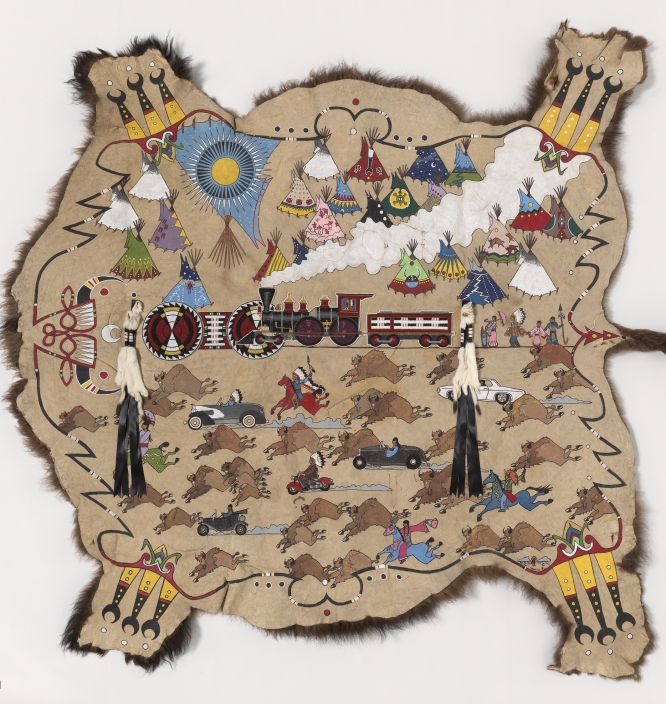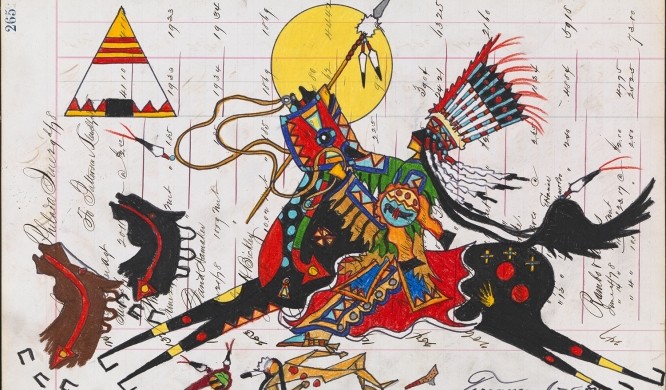“Unbound: Narrative Art of the Plains” Offers Rarely Seen Historic Native American Masterworks, Unveils Contemporary Works by 16 Artists
National Museum of the American Indian Exhibition Traces Evolution of the Narrative Tradition
Vibrant storytelling of society, war and peacetime, repression and expression is found within the historic narrative artworks of Native peoples of the Great Plains. “Unbound: Narrative Art of the Plains,” an exhibition opening Saturday, March 12, at the Smithsonian’s National Museum of the American Indian, George Gustav Heye Center in New York, presents rarely seen works by some of the most important figures to have used this style, including Bear’s Heart (Southern Cheyenne), Zo-tom (Kiowa) and Long Soldier (Hunkpapa Lakota). Their narratives exist along a continuum that carries tradition through to artists working in this style today.
“Unbound” celebrates these narratives with the debut of nearly 50 new works by contemporary Native artists commissioned exclusively for this exhibition. Often referred to as “ledger art” because of the many Plains artists who illustrated ledger notebooks in the 19th century, narrative art employs a dynamic range of imagery to express the ‘now’ of generations of Native people—voices too strong to be bound to any medium.
“When we look at American history that involves Native Americans, especially as it is frequently taught in schools, too often the narratives that come forth are from the viewpoints of non-Native people,” said Kevin Gover (Pawnee), director of the museum. “The artists showcased in ‘Unbound’ reflect nearly two centuries of Native self-expression and with that, a fuller, vastly more contextualized view of the indigenous experience, regardless of the time period.”
The narrative tradition takes root in warrior artists of the 18th century who recorded visionary experiences and successes in battle on buffalo-hide tipis, robes and shirts. Artists also began pictorially recording significant events from each prior year; these became known as “winter counts.” As trade with settlers broadened in the 19th century, new media and tools became available to artists, including pencils, crayons, canvas, muslin and paper.
The beginning of the Reservation Era (1870–1920) saw a transformation in narrative content. As policies set by the U.S. government encroached upon the Native identities of people of the Plains, pictorial drawings became a crucial means of addressing cultural upheaval. Many Native artists recorded their experiences in surplus government accounting notebooks, leading the style to be referred to as “ledger art,” which today is used interchangeably with “narrative art.” This style was revived in the 1960s, burgeoned during the American Indian Movement of the 1970s and continues in various media to this day.

Dallin Maybee (Arapaho), Conductors of Our Own Destiny, 2013. On view in “Unbound: Narrative Art of the Plains,” opening March 12, 2016, at the Smithsonian’s National Museum of the American Indian in New York.
Photo by Ernest Amoroso, National Museum of the American Indian
Native artists selected for “Unbound” who are currently working in the narrative style confront modern and historic issues through a mix of approaches. Humorous illustrations byDwayne Wilcox (Oglala Lakota) offer societal commentary on everyday Native life, a reflection of self-described personal sensibility similar to entertainer Stephen Colbert. Dallin Maybee (Northern Arapaho/Seneca), an attorney and chief operating officer for the Southwestern Association for Indian Arts, uses his art to explore Native identity and the influence of tradition on contemporary life. Terrance Guardipee(Blackfeet) reflects his heritage and culture through vivid illustrations of Blackfeet history. Other notable artists includeRonald Burgess (Comanche), Sherman Chaddlesone(Kiowa), David Dragonfly (Blackfeet/Assiniboine), Lauren Good Day Giago (Arikara/Hidatsa/Blackfeet/Plains Cree),Darryl Growing Thunder (Assiniboine/Sioux), Juanita Growing Thunder-Fogarty (Assiniboine/Sioux), Vanessa Jennings (Kiowa/Pima), Chester Medicine Crow(Apsáalooke [Crow]), Chris Pappan (Osage/Kaw/Cheyenne River Lakota), Joel Pulliam (Oglala Lakota), Martin E. Red Bear (Oglala/Sicangu Lakota), Norman Frank Sheridan(Southern Cheyenne/Arapaho) and Jim Yellowhawk(Cheyenne River Lakota).
National Museum of the American Indian
Broadway, New York, NY 10274
www.nmai.si.edu
Courtesy of the National Museum of the American Indian



















